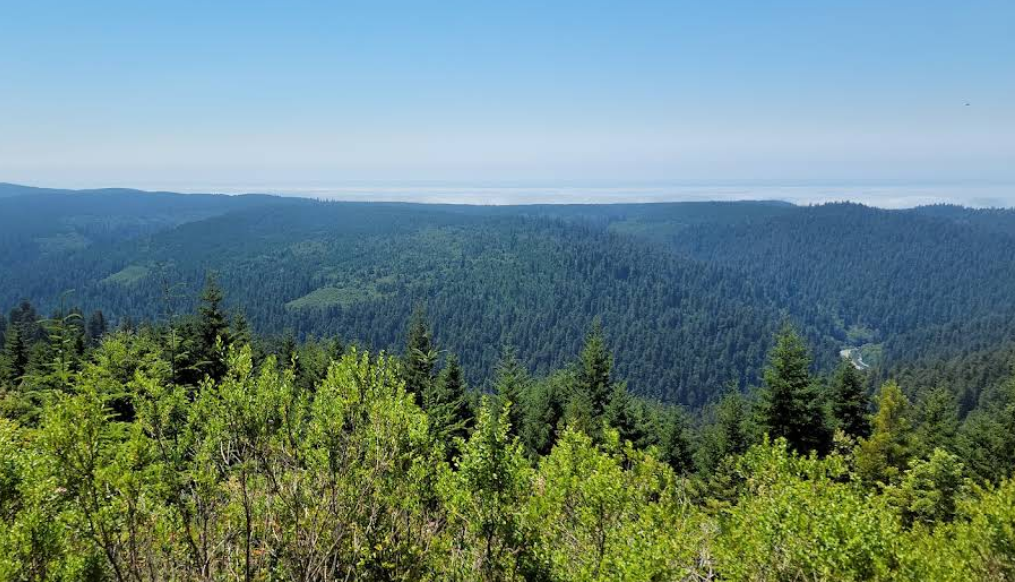There are few places on Earth as humbling, awe-inspiring, and rejuvenating as California’s Redwood National and State Parks. Towering ancient trees that have stood for thousands of years, misty forest trails, majestic elk, and quiet fern canyons all paint a picture straight out of a fantasy novel. This iconic landscape is more than just a backdrop for scenic drives and Instagram-worthy photos — it’s a vibrant, living ecosystem full of wonder, stories, and incredible biodiversity.
Whether you’re planning a road trip up California’s coast, looking to immerse yourself in nature’s grandeur, or wanting to stand in the shadow of Earth’s tallest trees, Redwood National and State Parks offer a transformative experience unlike any other. Let’s dive deep into everything this stunning park has to offer, from its history and trails to rare wildlife and even a local legend.
Where Are Redwood National and State Parks?
Located in northern California, these parks stretch across Humboldt and Del Norte Counties, with Crescent City often serving as a northern gateway. The parks consist of four distinct protected areas:
- Redwood National Park
- Jedediah Smith Redwoods State Park
- Del Norte Coast Redwoods State Park
- Prairie Creek Redwoods State Park
Together, they encompass nearly 140,000 acres of breathtaking coastal forest, grasslands, and riverways.
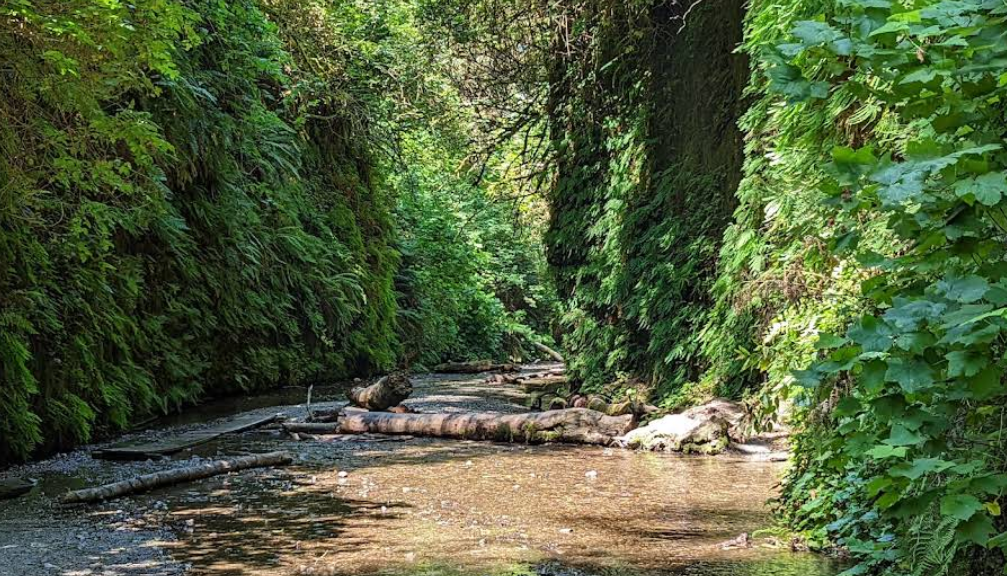
Map Location
A Brief History of the Redwoods
The coast redwoods (Sequoia sempervirens) are among the most majestic and awe-inspiring living organisms on the planet. Towering into the sky at heights of over 370 feet and living for more than 2,000 years, these ancient giants have silently witnessed the rise and fall of civilizations, shifts in climate, and centuries of human exploration. They are true timekeepers of the Earth — guardians of the Pacific coast.
Long before California became a state or the Gold Rush lured settlers westward, Indigenous peoples lived among the redwoods, coexisting with the land in harmony. Tribes like the Yurok, Tolowa, and Chilula understood the trees’ importance — not only as shelter or material but as spiritual entities. Ceremonies and oral traditions tied directly to the redwoods have been passed down for generations, with deep reverence and respect.
By the mid-1800s, the narrative shifted. As fortune-seekers poured in during the Gold Rush, the redwoods weren’t seen as sacred — they were seen as lumber. Logging companies descended upon Northern California with saws and steam engines, clear-cutting vast swaths of ancient forest. The trees that had stood for millennia were felled in a matter of hours. Entire groves disappeared, their trunks floated downriver to feed the booming construction needs of San Francisco and beyond.
It didn’t take long for concerned naturalists and local citizens to realize the irreversible damage being done. By the early 20th century, preservation movements began to gain traction. The Save the Redwoods League, founded in 1918, was at the forefront of this battle. Through strategic land purchases, lobbying, and educational campaigns, they ignited a passion for redwood protection across the country.
Thanks to their efforts and the support of conservation-minded politicians, Redwood National Park was officially established in 1968. Over time, additional land was added, and partnerships between state and federal agencies helped protect even more of these ancient groves. Today, the combined Redwood National and State Parks span more than 130,000 acres.
What makes these trees even more remarkable isn’t just their size or age — it’s their resilience. Coast redwoods can survive wildfires, floods, and even the death of their central trunk, often regenerating from their root system. Their bark can be over a foot thick, protecting them from heat and disease. Some trees have scars from fires hundreds of years ago and are still growing strong.
Walking through a redwood forest today is like stepping into a different world. The air is cooler, quieter. Sunlight filters down through a green canopy so high up it’s hard to gauge its depth. The smell of damp earth and moss is grounding. It’s no wonder so many visitors say the experience is spiritual.
And while the fight to protect these giants isn’t over — with threats like climate change and illegal logging still looming — the redwoods stand tall as a living legacy. They’re a powerful symbol of what we stand to lose if we don’t take conservation seriously — and what we can save when we come together with purpose.
Top Things to Do in Redwood National and State Parks
🌲 Hike Among the Giants
- Lady Bird Johnson Grove Trail – A gentle 1.5-mile loop that showcases old-growth forest and is great for first-timers.
- Tall Trees Grove Trail – A longer, more strenuous 4.5-mile trail that leads you into a grove with some of the tallest trees in the world.
- Fern Canyon – A magical canyon with 50-foot high walls covered entirely in lush green ferns. It’s so cinematic, it was featured in Jurassic Park 2!
🦌 Wildlife Watching
- Roosevelt elk are frequently seen in the Prairie Creek area.
- Spotting black bears, raccoons, and a variety of songbirds is also common.
- Keep an eye out for gray whales during their migration season along the coast.
🚗 Scenic Drives
- Newton B. Drury Scenic Parkway – A 10-mile road that winds through some of the tallest trees in the park.
- Howland Hill Road – A rustic, unpaved route that offers some of the most intimate encounters with the redwood forest.
🚴 Biking and Horseback Riding
Several trails within the park allow for mountain biking and equestrian travel, providing unique perspectives and solitude.
🏕️ Camping and Backcountry Adventures
- Reserve a spot at Gold Bluffs Beach Campground or Elk Prairie Campground for beachside or forest camping.
- Backcountry permits allow for deeper exploration and overnight treks.
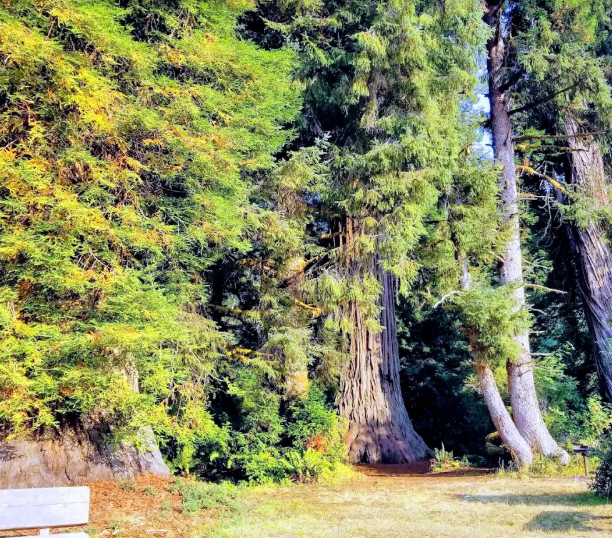
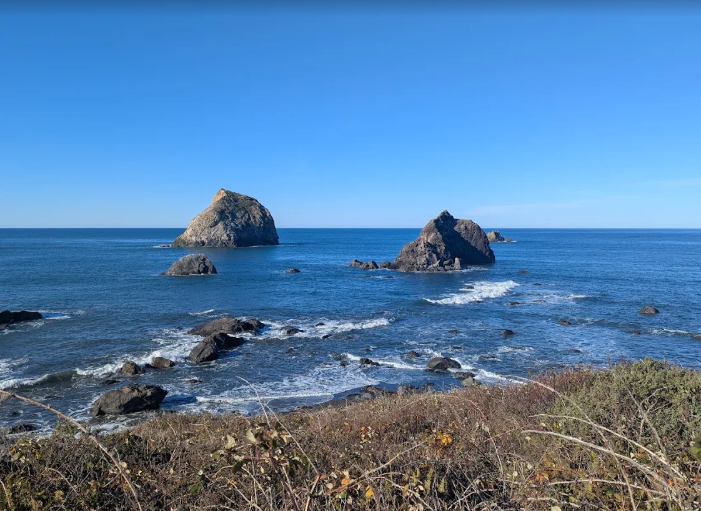
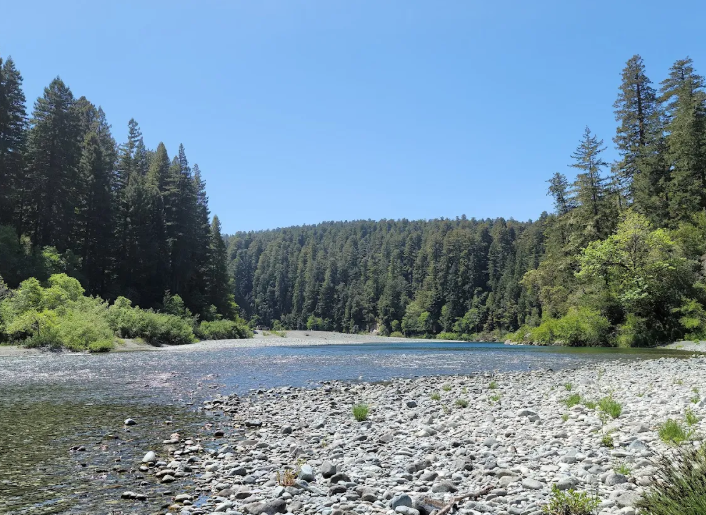
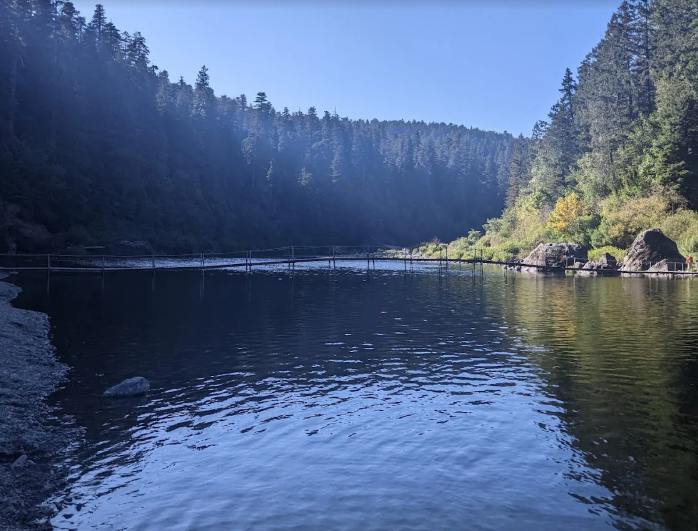
A Park of Microclimates
One of the most intriguing features of the redwood parks is the varied microclimates. You might be hiking under a fog-drenched canopy in the morning and sunbathing on the beach by afternoon. Fog plays an essential role in the ecosystem, providing moisture to the trees even during dry summer months.
Local Legend: The Ghost Elk of Prairie Creek
Among the dense, misty groves of Prairie Creek Redwoods State Park, there’s a story whispered between rangers and locals alike — a legend that’s haunted hikers and fired imaginations for generations. They call it the Ghost Elk of Prairie Creek, a spectral guardian of the redwoods said to appear when a soul is in need.
The legend describes an enormous bull elk with glowing silver antlers, so luminous they light up the fog. Unlike other Roosevelt elk that roam the park, this one moves without a sound. He doesn’t react to footsteps, doesn’t flee when approached. Instead, he appears during moments of deep emotional turmoil — fear, grief, uncertainty — and disappears just as mysteriously as he arrived.
Some say they saw him on the trail after getting lost, moments before finding their way back. Others claim he stood silently watching as they sat alone, overwhelmed by personal struggles. Nearly all who encounter him describe the same feeling: an overwhelming sense of peace, as though the forest itself had reached out and reminded them they were not alone.
A park ranger once told of a solo backpacker who, after days of heavy rain and a twisted ankle, was ready to give up. He limped into a clearing and saw the Ghost Elk standing just beyond the trees. He followed the animal — not out of fear, but trust — and within minutes, found a ranger cabin he didn’t know existed.
Skeptics say it’s just a myth. Maybe it’s light reflecting strangely in the fog. Maybe it’s just another elk, misidentified in the eerie twilight hours. But those who’ve experienced it swear it wasn’t just an animal — it was something more. Something sentient. A protector of sorts.
Native American stories in the region speak of spirit animals that guide lost travelers and appear during rites of passage. The Ghost Elk may be a continuation of these traditions — a blending of folklore, spiritual beliefs, and the undeniable power of nature to move us.
Even visitors who haven’t seen the elk describe feeling a presence in the woods. That eerie silence, where every sound seems muffled by moss and mist. That moment when the wind dies down, and it feels like the trees are listening. Or the strange synchronicity of solving a personal dilemma while sitting beside a redwood stream, as though clarity floated in with the breeze.
The Ghost Elk is more than just a ghost story. He’s a symbol — of introspection, healing, and the quiet wisdom of the natural world. Whether real or imagined, his legend continues to grow, etched into the soul of Prairie Creek as deeply as the elk trails winding through the forest floor.
So if you find yourself alone in the redwoods, especially during moments of doubt or crisis, keep an eye on the shadows. You just might spot a silver glimmer among the trees — and leave with more than just photos and memories.
Best Time to Visit
Redwood National and State Parks are open year-round, but here’s a breakdown of the seasons:
- Spring (March – May): Wildflowers bloom, fewer crowds.
- Summer (June – August): Most popular time to visit; ideal weather.
- Fall (September – November): Crisp air, changing leaves, and less crowded.
- Winter (December – February): Rainy and moody — but perfect for solitude lovers and dramatic photography.
Tips for Visiting Redwood National and State Parks
- No Entrance Fee: These parks are free to enter!
- No Cell Service: Download maps beforehand or grab a paper map at the visitor centers.
- Dress in Layers: Weather can shift quickly.
- Pack In, Pack Out: Help preserve the magic by leaving no trace.
- Permits for Tall Trees Grove: Obtain a free permit online or from a visitor center.
Why the Redwoods Matter
Standing beneath a towering redwood, it’s easy to be humbled. But beyond their towering beauty and serene atmosphere, these ancient trees are essential to the planet’s health, biodiversity, and even to our human spirit. They matter in ways far deeper than the eye can see.
🌬️ Climate Guardians: Nature’s Carbon Vaults
Coast redwoods are some of the most effective carbon absorbers on the planet. Their massive size, fast growth, and long lifespan allow them to sequester carbon dioxide at a scale few species can match. In fact, studies have shown that redwood forests store more carbon per acre than any other type of forest, including tropical rainforests.
That means protecting redwoods isn’t just about saving trees — it’s about combating climate change at a global level. Every living redwood acts as a long-term carbon sink, locking away greenhouse gases that would otherwise accelerate global warming.
But the real magic lies in what happens beneath the surface.
Redwoods have complex root systems that form mutual support networks. While shallow, these roots stretch outward, intertwining with neighboring trees. They share nutrients, water, and even distress signals through underground fungal networks — a kind of biological internet called the mycorrhizal network. This helps them survive fires, droughts, and other threats, together.
🦉 Home to an Ancient Ecosystem
The redwood forest is more than just trees. It’s a living ecosystem, home to rare and endangered species that depend on its unique microclimate.
Within the canopy — sometimes over 30 stories high — you’ll find hanging gardens of mosses, ferns, and even salamanders. Yes, you read that right: cloud-dwelling amphibians that never touch the ground, spending their entire lives in the treetops.
On the forest floor, banana slugs, Roosevelt elk, black bears, and Pacific fishers make their homes among the ferns and fallen logs. Owls roost in the ancient snags. River otters and salmon thrive in the clear, cold streams winding through the groves.
Many of these species rely on the redwoods’ cool, moist environment, which helps regulate temperatures and retain water — especially crucial as California faces increasing drought conditions.
🔥 Resilience Forged Over Millennia
Redwoods are survivors.
Their bark can be up to 12 inches thick, rich in tannins that resist insects, disease, and even fire. When wildfires sweep through the forest — as they have for thousands of years — many redwoods don’t die. Instead, they regenerate. New growth sprouts from their base or even from burnt trunks. Some trees have visible fire scars dating back hundreds of years, standing tall despite having burned more than once.
And unlike most trees, redwoods can clone themselves. A fallen redwood often sparks a ring of new growth around its base, called a fairy ring — genetically identical shoots that carry on its legacy.
These trees are not just resilient — they’re symbols of survival. In a world facing increasing environmental pressure, their continued existence reminds us that life finds a way, and that nature can endure — if we protect it.
🌱 Spiritual and Emotional Significance
For many, the redwoods are more than biological wonders — they’re sacred.
Stepping into a redwood grove is often described as a spiritual experience. The stillness. The filtered light. The towering trunks disappearing into the sky. It creates a sense of reverence, of connection to something ancient and wise. You feel small, yes — but not insignificant. You feel part of a much bigger story.
This emotional power is one reason why so many people return to the redwoods in times of grief, celebration, or transition. Weddings, memorials, pilgrimages — the redwoods hold space for all of it.
It’s no coincidence that early conservationists often described the groves using cathedral imagery. John Steinbeck once wrote that “the redwoods… are not like trees, they are ambassadors from another time.”
🛡️ A Call to Protect What Remains
Despite their strength, redwoods are not invincible.
Only about 5% of the original old-growth redwood forests remain today. Logging, development, and climate change continue to threaten their survival. Even second-growth forests — younger redwoods trying to fill the void — face challenges from fragmented habitats and invasive species.
That’s why organizations like the Save the Redwoods League, National Park Service, and many Indigenous tribes are working tirelessly to protect and restore redwood ecosystems. They plant new trees, reconnect fragmented habitats, and educate the public on the redwoods’ vital role.
But you don’t need to be a scientist or a ranger to help. Every visit, every donation, every story shared about these trees helps build awareness and momentum.
❤️ Why They Matter to You
If you’ve ever walked through a redwood forest, you already know.
They remind us of what the world once was — and still could be. They show us that strength comes not from rushing forward, but from standing tall and holding fast. They teach us that even in silence, there is deep power.
So when you visit, don’t just admire them. Listen. Breathe. Let the redwoods remind you what matters: balance, connection, endurance, and hope.
Because saving the redwoods isn’t just about trees — it’s about preserving the best parts of ourselves.
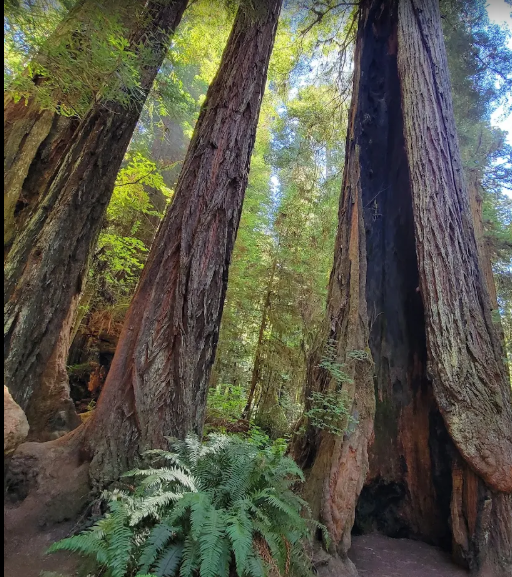
Humbled by Giants
There’s something deeply humbling about standing beneath a redwood that has towered silently for over a thousand years. The sheer size of these trees — some as wide as a house and taller than a skyscraper — reminds us how small we are in the grand scheme of time and nature. You can feel it in your chest: the stillness, the awe, the sense that you’re just a moment in the life of something much greater.
Surrounded by their quiet majesty, many visitors describe a shift in perspective. Problems feel smaller, distractions fade, and the weight of modern life seems to lift — if only for a while. In a world that often pulls our attention in a thousand directions, the redwoods offer a rare chance to feel grounded, present, and connected to something timeless.
Walking Among Giants: A Final Reflection
There are places on Earth that defy description. Places that humble the ego, quiet the mind, and awaken something primal in the soul. Redwood National and State Parks is one of those places.
To walk among trees that have stood since the fall of the Roman Empire is to witness time in its purest form. Their presence is not just impressive — it’s sacred. They don’t just reach toward the sky; they anchor the land, hold ecosystems together, and remind us what real strength looks like: patient, silent, enduring.
But this isn’t a museum — it’s a living, breathing world. Elk move through the ferns like ghosts. Banana slugs leave shining trails across the forest floor. Mist clings to branches like ancient stories refusing to be forgotten.
Here, solitude doesn’t feel lonely. It feels like clarity. In the hush beneath the canopy, you remember who you are — and who you’re not. You stop scrolling. You stop racing. You just… exist.
And that’s the magic of the redwoods. They ask nothing of you except presence. No cell signal, no ads, no deadlines. Just you, the towering trees, and the rhythm of your own breath.
Whether you hike the Lost Man Creek Trail or stand still in Fern Canyon, you’re part of something bigger — not metaphorically, but literally. You are dwarfed, humbled, and protected all at once.
You’ll find traces of legend here — maybe even the Ghost Elk. But more likely, you’ll find traces of yourself that modern life made you forget.
You’ll hear your own heartbeat again.
You’ll notice how your child’s voice echoes differently in a forest cathedral.
You’ll taste water with more gratitude.
You’ll remember how fresh pine smells after rain.
You’ll look up — really look up — and wonder why you ever stopped doing that.
You’ll realize that the world doesn’t revolve around you, and somehow, that will make you feel more alive.
You’ll feel small. You’ll feel immense. You’ll feel both, and understand how they can coexist.
And when you leave, you’ll carry it with you — the hush, the awe, the grounding.
You’ll walk differently, slower, more awake.
You’ll want to protect what you’ve seen.
Because the redwoods aren’t just trees. They’re witnesses. They’ve watched humanity rise and fall, war and peace, silence and noise.
And still, they stand.
🎒 Looking for rugged, reliable gear? Check out our Shop, browse our curated eBay storefront, or explore top-rated outdoor clothing and boots at TideWe — tested by adventurers like you!
Book your stay near the park with trusted options on Booking.com — from cozy cabins to ocean-view hotels.
Final Thoughts
Redwood National and State Parks are not just a destination — they’re a journey into Earth’s oldest living cathedrals. To walk beneath the canopy of these giants is to feel small, yet infinitely connected to something greater.
Whether you’re an experienced hiker, a curious traveler, or a family on vacation, the redwoods will leave you changed. And when you go, take time to listen — not just to the rustling of leaves and chirping of birds — but to yourself. These trees have a way of reminding us what truly matters.
Now, go explore, wander wide, and breathe deep.
Northern River Adventures Your guide to outdoor discovery 🌲
